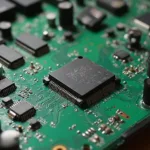The OBD2 ECT (Engine Coolant Temperature) sensor plays a crucial role in your vehicle’s performance and efficiency. Understanding the obd2 ect sensor wires, their function, and potential issues can save you time and money on repairs. This article provides a comprehensive guide to everything you need to know about these essential wires.
The ECT sensor communicates the engine’s temperature to the Engine Control Unit (ECU). This information is vital for adjusting the fuel injection, ignition timing, and emissions control systems. Faulty obd2 ect sensor wires can disrupt this communication, leading to various performance problems. Let’s delve deeper into the specifics.
Decoding the OBD2 ECT Sensor Wires
Typically, the ECT sensor has two or three wires. Each wire has a specific function:
- Signal Wire: This wire carries the voltage signal from the sensor to the ECU. The voltage changes based on the engine’s temperature.
- Ground Wire: This wire provides a ground path for the sensor’s circuit.
- Power Wire (if present): Some sensors have a dedicated power wire supplying a 5-volt reference voltage.
Understanding the role of each wire is crucial for diagnosing and troubleshooting issues.
A common problem is a break in the signal wire, which can lead to inaccurate temperature readings. This might cause the engine to run rich or lean, affecting fuel efficiency and performance.
Troubleshooting OBD2 ECT Sensor Wire Issues
If you suspect a problem with your obd2 ect sensor wires, here’s a step-by-step guide to help you troubleshoot:
- Locate the ECT Sensor: Consult your vehicle’s repair manual to find its location.
- Inspect the Wires: Look for any visible damage, such as cuts, breaks, or corrosion.
- Check the Connectors: Ensure the connectors are securely attached and free from corrosion.
- Test the Wires with a Multimeter: Use a multimeter to check the continuity and voltage of each wire.
By following these steps, you can identify and fix potential issues with the obd2 ect sensor wires.
obd2 codes for 1999 volvo v70 can also be helpful in diagnosing these problems.
Common Symptoms of Faulty OBD2 ECT Sensor Wires
Several symptoms may indicate a problem with your ECT sensor wires:
- Check Engine Light: The check engine light may illuminate if the ECU detects a problem with the ECT sensor circuit.
- Poor Fuel Economy: Inaccurate temperature readings can lead to inefficient fuel consumption.
- Rough Idle: A faulty ECT sensor can cause the engine to idle roughly or stall.
- Difficulty Starting: In extreme cases, a malfunctioning ECT sensor can prevent the engine from starting.
- Overheating: While less common, damaged wires can contribute to engine overheating.
Recognizing these symptoms can help you address the issue promptly.
Why Accurate ECT Readings are Essential
Accurate ECT readings are crucial for optimal engine performance. The ECU relies on this information to regulate several vital functions. A properly functioning ECT sensor ensures efficient combustion, reduced emissions, and improved fuel economy. Ignoring issues with the obd2 ect sensor wires can lead to more significant problems down the road.
What happens if my ECT sensor wires are damaged?
Damaged ECT sensor wires can lead to inaccurate temperature readings, causing the ECU to miscalculate fuel injection and ignition timing.
How can I test my ECT sensor wires?
You can test the wires using a multimeter to check for continuity and voltage.
Where can I find the wiring diagram for my vehicle’s ECT sensor?
Consult your vehicle’s repair manual for the specific wiring diagram.
obd2 to usb c can help diagnose car problems.
Conclusion
Understanding the function and importance of obd2 ect sensor wires is essential for maintaining your vehicle’s health and performance. Regular inspection and prompt troubleshooting can prevent minor issues from escalating into costly repairs. By being proactive, you can ensure your engine runs smoothly and efficiently for years to come. Remember, addressing even seemingly minor electrical issues like these can significantly impact your vehicle’s overall performance and longevity.
FAQs
-
What is the function of the OBD2 ECT sensor? The ECT sensor measures the engine coolant temperature and sends this information to the ECU.
-
How many wires does an ECT sensor typically have? Most ECT sensors have two or three wires.
-
What are the common symptoms of faulty ECT sensor wires? Common symptoms include a check engine light, poor fuel economy, rough idle, and difficulty starting.
-
How can I test my ECT sensor wires? You can test them with a multimeter to check for continuity and voltage.
-
Where can I find information on my vehicle’s specific ECT sensor wiring? Consult your vehicle’s repair manual.
obd2 p0078 is another helpful resource.
obd2 344 offers further information on OBD2 codes.
obd2 code for expedition spark plug is also a valuable resource for OBD2 troubleshooting.
For further assistance, contact us via WhatsApp: +1(641)206-8880, Email: [email protected] or visit us at 789 Elm Street, San Francisco, CA 94102, USA. Our customer service team is available 24/7.


